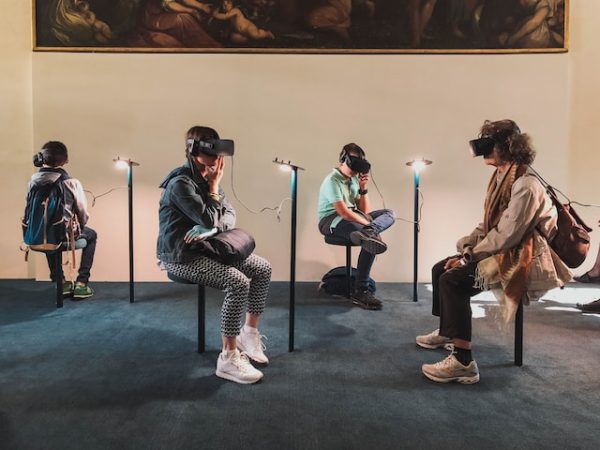
The Impact of Virtual Reality on Our Lives. Virtual reality (VR) is a technology that has rapidly gained popularity in recent years. It has transformed various industries, including entertainment, education, healthcare, and business. With the ability to create fully immersive experiences, virtual reality has opened up new possibilities and opportunities for human interaction and exploration. In this article, we will explore the impact of virtual reality on our lives, from the ways it has changed our entertainment experiences to its use in medical training and therapy. We will also look into the social and psychological effects of virtual reality and the challenges and limitations of the technology. Finally, we will discuss the potential advancements and the future applications of virtual reality.
Introduction to Virtual Reality
Virtual reality (VR) is a technology that can simulate a three-dimensional environment, providing an immersive experience to the user. It is achieved through a combination of specialized hardware, software, and sensory devices that replicate the user’s surroundings and respond to their movements in real-time. Virtual reality has been gaining popularity in recent years, and its impact is being felt across various sectors of activity.
What is virtual reality?
Virtual reality is a computer-generated environment that can simulate reality or create an entirely new one, allowing users to immerse themselves in a virtual world. This is usually achieved through the use of specialized headsets, earphones, and sensory tools. VR engages the user’s senses, primarily sight and hearing, to create an illusion of reality. With the proper hardware and software, VR can simulate a broad spectrum of real-world scenarios, from historical sites to outer space.
A brief history of virtual reality
The idea of virtual reality dates back to the 1960s, but it wasn’t until the 1990s that it became a reality. The first VR headset was created in 1968 by Ivan Sutherland, but it was bulky, expensive, and had very low resolution. In the 1990s, gaming and entertainment companies began experimenting with virtual reality technology. However, it wasn’t until the 2010s that VR became more sophisticated and accessible to the general public, with the introduction of more powerful computers and affordable VR systems like the Oculus Rift and HTC Vive.
Virtual Reality in Entertainment
Virtual reality is transforming the entertainment industry by providing more immersive experiences to users. Industries like gaming and movies are leveraging VR technology to create new and exciting experiences for viewers.
How virtual reality is transforming gaming industry
Virtual reality has brought a new dimension to the gaming industry, allowing gamers to immerse themselves in a virtual environment that feels like the real world. VR provides gamers with a more immersive experience, with games that feel and look more real than traditional ones. With 360-degree views, gamers can feel like they are inside the game, making it a more interactive and engaging experience.
Virtual reality in movies
Virtual reality is also making its way into the world of movies, providing viewers with an immersive experience like never before. With the use of VR headsets, viewers can be transported to a different world and experience the movie in a more interactive way. VR also allows for 360-degree viewing, making the experience feel more personal and engaging.
Virtual Reality in Education
Virtual reality has enormous potential for education, providing teachers and students with a new way of learning.
Virtual reality in classroom
Virtual reality is being used in the classrooms to provide immersive and interactive learning experiences to students. With VR, students can visit historical sites, explore the universe, and even dissect virtual frogs. This kind of learning experience is more engaging, and it allows students to retain more information.
Advantages of virtual reality in education
Virtual reality has many advantages in education, including better engagement, improved retention, and increased understanding of abstract concepts. With VR, students can interact with each other in a virtual environment, making it a more collaborative learning experience. VR technology also allows for a customized learning experience, catering to different learning styles and preferences.
Virtual Reality in Healthcare
Virtual reality technology is being used in healthcare to train medical professionals and provide therapy to patients.
Virtual reality in medical training
Virtual reality is being used in medical training to provide students and doctors with a more immersive and hands-on experience. With virtual reality, trainees can simulate surgeries and procedures, allowing them to practice and improve their skills in a safe and controlled environment.
Virtual reality in therapy
Virtual reality is also being used in therapy to treat patients with PTSD, anxiety, and other mental health conditions. VR can be used to create virtual environments that help patients confront their fears and anxieties, and even treat physical pain. Virtual reality therapy has shown promising results and is becoming an essential tool in treating mental health conditions.
Virtual Reality in Business
Virtual reality technology has revolutionized the way businesses operate. It has opened up numerous opportunities for organizations to enhance their product design and customer experience.
Virtual reality in product design and prototyping
Virtual reality has made it possible for businesses to design and prototype products in a more cost-effective and efficient manner. With VR, companies can create virtual models of their products and test them in different scenarios without having to build physical prototypes, thus saving time and money.
Virtual reality in customer experience
Virtual reality has also transformed the way businesses interact with and engage their customers. It enables them to create immersive experiences that allow customers to virtually experience their products or services, making it easier for them to make informed decisions. For example, real estate companies can create virtual property tours for their customers, while automotive companies can offer virtual test drives of their vehicles.
Social and Psychological Impact of Virtual Reality
While virtual reality has many benefits, it is important to consider its potential impact on society and mental health.
Effects of virtual reality on social interaction
There are concerns that virtual reality may lead to decreased social interaction, as people become more immersed in virtual worlds and spend less time interacting with others in the real world. However, some experts argue that VR could actually enhance social interaction by enabling people to connect and communicate with others from different parts of the world.
Impact of virtual reality on mental health
Virtual reality has shown promise in treating mental health conditions such as phobias and anxiety disorders. However, there are also concerns that prolonged exposure to virtual environments may lead to addiction, disorientation, and other negative effects on mental health.
Challenges and Limitations of Virtual Reality
Despite its many benefits, virtual reality also faces several challenges and limitations.
Technical challenges of virtual reality
One of the biggest challenges facing virtual reality is the technical limitations of the hardware and software used to create and experience VR environments. The technology is still in its early stages, and there is a need for more advanced hardware and software to make virtual reality experiences more realistic and immersive.
Health concerns
Another challenge facing virtual reality is the potential health risks associated with prolonged exposure to virtual environments. Some users have reported experiencing motion sickness, eye strain, and other physical discomforts after using VR technology for extended periods.
Future of Virtual Reality
Despite its challenges, virtual reality is poised to become an increasingly important part of our lives in the future.
Possible advancements in virtual reality technology
As technology continues to advance, we can expect virtual reality to become more realistic and immersive. Advancements in areas such as haptic feedback, artificial intelligence, and machine learning will make it possible for VR to create even more engaging and interactive experiences.
Applications of virtual reality in the future
Virtual reality technology has numerous potential applications in fields such as education, healthcare, and entertainment. From virtual classrooms to surgical simulations, the possibilities for VR are endless, and we can expect to see it playing an increasingly important role in our lives in the years to come.In conclusion, virtual reality has the potential to revolutionize the way we interact with the world around us. While the technology still has its limitations and challenges, it is exciting to think about the possibilities that it offers. As virtual reality continues to evolve, we can expect to see it integrated into more aspects of our daily lives. Whether it’s for entertainment, education, or healthcare, virtual reality has the power to change our lives in ways we never thought possible.
Frequently Asked Questions
What are the effects of virtual reality on mental health?
Virtual reality has shown promise in treating different mental health conditions, such as anxiety disorders, post-traumatic stress disorder (PTSD), and depression. It offers a safe and controlled environment for patients to confront their fears, trauma, or negative thoughts. However, improper use or overuse of virtual reality may lead to negative effects such as nausea, headaches, and eyestrain.
What are the limitations of virtual reality?
Virtual reality technology has come a long way, but it still has its limitations. The technology is currently expensive and not accessible to everyone, especially those in developing countries. It also requires a powerful computer and a high-end headset to run smoothly, which makes it difficult for some individuals to use. Virtual reality may also have negative effects on physical health, such as motion sickness and eye strain, if not used properly.
What is the future of virtual reality?
The future of virtual reality looks promising. As the technology continues to advance, we can expect to see more affordable and accessible options for consumers. Advances in eye-tracking, haptic feedback, and gesture recognition will enable more realistic and immersive experiences. Virtual reality will also continue to transform various industries, such as education, healthcare, and entertainment. In the future, virtual reality may become an integral part of our daily lives, changing the way we work, play, and interact.
How can virtual reality be used in education?
Virtual reality has many applications in education. It can be used to simulate real-world scenarios and provide learning experiences that are not possible in the traditional classroom setting. For example, students can explore historical sites, travel to different parts of the world, or interact with complex scientific concepts in a safe and controlled environment. Virtual reality can also be used to provide hands-on training for skills that are difficult or dangerous to practice in real life, such as surgery or flight simulation.
Read More :








